
Texas Brown Tarantula
Adult body length is 13-14 cm, suitable temperature is 28-30 ℃, and suitable humidity is 65%. It is recommended to use moist peat, coconut brick and clay as the substrate. It tak
Origin: Cuba/Caribbean
Caribbean golden grey bird-eating spiderSpider (Latin name: Phormictopus platus) native to the tropical rainforests of Cuba and the Caribbean, this genus is relatively rare and The largest species, the adult individual displays a shiny golden color, a very noble looking pet Species of tarantulas. The largest individual ever found is said to have a foot span of more than 25 centimeters.
Chinese name: Caribbean golden grey bird
English name: Phormictopus platus
Subfamily: Theraphosinae
Origin: Cuba/ Caribbean
Habitat: Land Type Tropical Rainforest
Adult Body Size: 20-25cm Foot Expansion
Optimum Temperature: 25-27℃
Appropriate humidity: 75%Substrate used: moist peat/coconut brick/clay
Life type: ground-dwelling
Whether to kick hair: Often
Fitness: Player Advanced
Adult body length 20-22+cm foot span, gray in juveniles, and red hairs gradually appear on the abdomen as the skin grows. When it grows to more than 6 cm, it starts to show golden color slowly. They grow at a much faster rate than species from dry regions.
The suitable temperature is 25-27℃, and the suitable humidity is 75%. It is recommended to use moist peat, coconut brick and clay as the substrate. Feeding can provide them with a thicker substrate and a shelter, which they may dig, although they are more than happy to accept ready-made burrows. Paying attention to maintaining humidity also needs attention, too drying may cause them to fail to molt or die from dehydration.
The difficulty of artificial propagation and low yields are the reasons for their relatively high prices. Their visibility in the pet tarantula market is not high, and they are only occasionally to see the types for sale. They may have some aggressiveness when they grow to a certain size, and their stinging hair is more useful to people, so they are not recommended for beginners to try to breed for the first time.